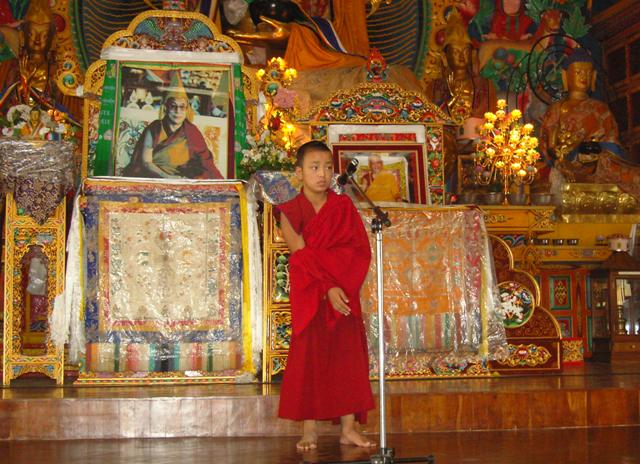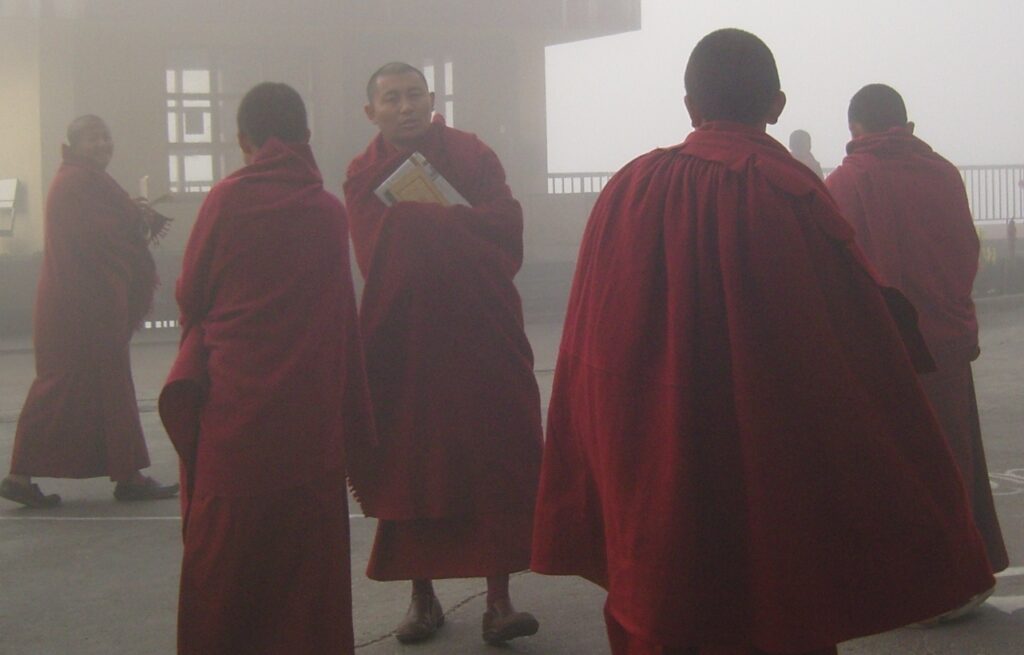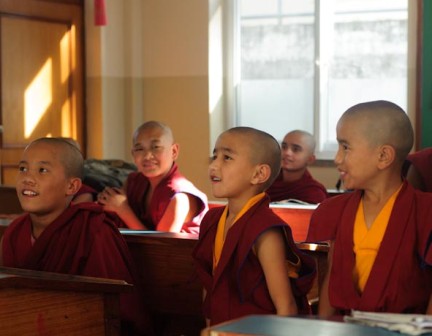
A Day in the Life of a Monastery

The weekly holiday on Saturday had been spent with friends or parents, cleaning the rooms, washing cloths – the usual chores that need to be done.
Every other Sunday special activities are on the schedule, such as public speaking (in Tibetan and English), spelling contest debate competions with other schools with the normal schedule starts again at 5 pm, filling the air with multitudes of sounds.
Outside the main assembly hall, some young monks practice the traditional art of Cham or Lama Dance. Cymbals are clashing, bodies moving, hands clapping to an ancient rhythm.
From the upper floor of the gompa the sounds of drums and chanting drift down; there the tantric monks perform the daily rituals and prayers for the monastery.
In the class rooms near the lower courtyard, the young monks are memorizing their evening prayers. The older monks walk around quietly in the courtyeard, reciting the philosophyl texts from memory in preparation for debate the next day.
After dinner, the monks from the philosophy class assemble in the debate hall to recite sutras. Someone is turning the big prayer wheel, the small bell tinkling along with every turn. From the valley, sounds of music, drums, and singing can be heard occasionally. It is the sound of Dharma in all its variations permeating the air.
Monday morning, the real business of prayers, study and school begins again with the morning puja at 5.30 am. The pujas performed are usually requested by members of Kopan’s world wide community. Breakfast is offered during the morning puja – simple fare: a cup of Tibetan tea, a piece of bread, if someone made a special offering, there might be some jam or even an omelet on the bread.

Memorizing starts at 7.30 am for all monks, and the murmur of hundreds of voices rises up in the air. Texts that are to be studied in class, daily prayers and pujasneed to be learned by heart. Every monk has to memorize a certain number of lines every day and is examined daily on his progress.
The Kopan clinic is open at this time for the small and big monks to attend to their the various small or big problems. Allopathic, Tibetan and Aryuvedic medicine are available, and usually the clinic is quite busy. Serious cases are taken to one of the local hospitals.
After the memorizing session there is a sudden burst of energy noticeable. Released from the constrictions of discipline for a short while, there is a lot of running around, shouting and laughing.

Then the bell rings and everybody disappears into their respective classrooms, to emerge again in time for lunch.
The food served at lunch is simple, nutritious, vegetarian, Nepal style, prepared in a clean modern kitchen. 380 meals are prepared three times a day, every day. The monks take turns Helping in the kitchen and serving the meal. Specially when momos (a kind of vegetable dumpling) are on the menu, extra helpers are always welcome.
The afternoon is filled with classes again till 4 pm when the memorizing classes start for the small monks. The older students go to their various philosophy classes, till dinner time at 6.30 pm. At 7.30 pm the bell rings for the last session of the day – chanting of the evening prayers, followed by debate, a lively and noisy affair with some monks jumping up and down to make their points more forcefully.
The day ends around 10.30 pm with dedication prayers and prostrations in the court yard. The soft sound of prayer recitations can be heard well into the night, together with the occasional clanging of the bell from the big prayer wheel, creating a peaceful atmosphere.

